
views
Preparing the Scene
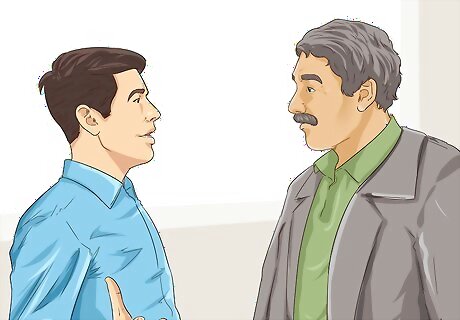
Find physical, athletic actors to work with. A fake fight scene requires real coordination. To make a convincing fight scene you need actors that can fight convincingly. Whether you're filming a one-on-one duel or a big brawl, you want actors who can carry themselves with fluidity and coordination. If your actors aren't comfortable moving a lot, you can still give them smaller parts in the fight. It will make your job much harder, however. Fake fighting is closer to dancing than actual brawling, and requires a similar level of coordination and athleticism.
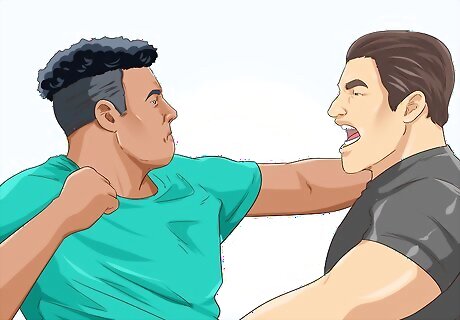
Decide on the tone and arc of the fight. Do you want a blazing fast kung-fu battle or a slow, intense brawl? Will the fight be one-sided or will the combatants be evenly matched? Maybe one character is getting beaten up badly, but comes behind at the very end to win. Whatever your film, figure out the feel and progression of the fight before you start choreographing it. How does each fighter behave? A noble warrior, for example, will fight very differently from a scoundrel pirate. Do you want gritty, realistic violence or something more fun and cartoonish? How serious is this fight? If you're not making the movie alone, show your cast and crew fight scenes from 3-4 movies you want your scene to look like. This helps everyone get on the same page.
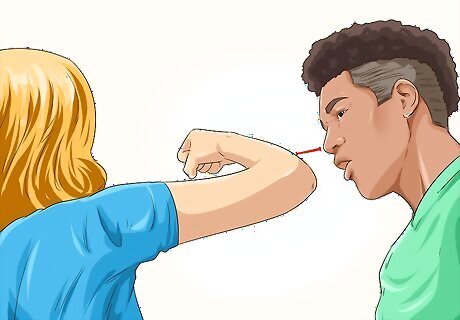
Keep all punches and kicks 6–8 inches (15.2–20.3 cm) away from the actors. This is non-negotiable -- any closer and you risk real injury, any further and the hit will look unconvincing. Say Kim needs to kick at Ron's head. There are two ways to play it. First, Kim can kick in front of Ron's face, arching her foot in front of his nose. Second, she can kick past his head, flying past his ear. A third method is to let Ron dodge the blow, which is much easier to shoot than fake contact because you don't need to "cheat" the impact of the kick.
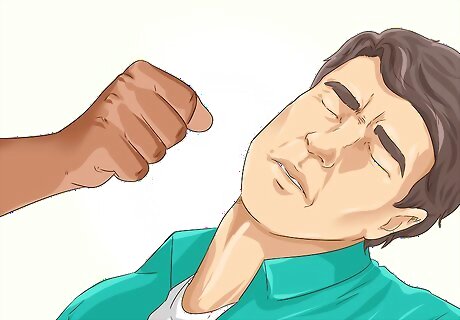
Coordinate the reaction to each hit to time it up with the action. If Kim is throwing that kick Ron needs to realistically get hit by it. As the kick passes his head, Ron should launch himself in the same direction, mimicking the contact. Take it at 50% speed at first so that both actors know exactly what is happening and where they need to go, then slowly ratchet up the speed with each rehearsal. Let each blow land where an actor just was for the best results. If Kim throws a punch, have Ron back up as he reacts to it, helping sell the movement.
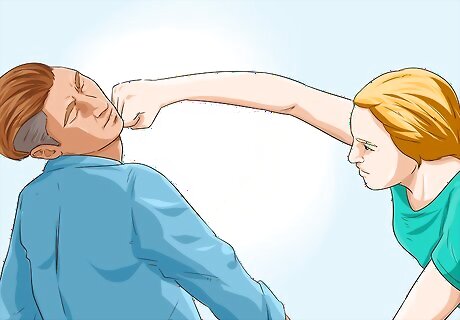
Let the person getting hit dictate any actual movement. Say Kim needs to throw Ron to the floor for the scene. Kim wouldn't ever actually throw Ron. Instead, she would just grab Ron, who would then throw himself to the floor. Kim would simply fake the throw by following Ron's lead. This makes the timing much more fluid and far safer, and should be used in a variety of scenarios: Say Kim grabs Ron's hand and breaks his arm at the elbow. All Kim should do is grab the hand, letting Ron move himself to the floor as she follows him down. If Kim needs to slam Ron's head against the wall, Ron should throw his head within six inches of the wall and fake the bounce back up. She simply follows his head with her hand.
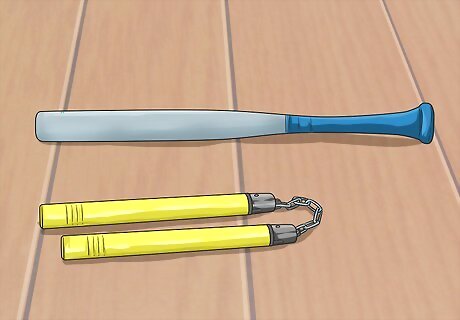
Purchase safe, movie-specific props. Never use a real weapon on set, even if it is supposed to be just seen in the background. Props should always be harmless and completely safe. In professional movies, prop masters must be professionally firearm trained, even with blanks and fake guns, and for a good reason -- even blanks have caused injury when played with or used inappropriately. You can purchase realistic foam baseball bats, swords, nunchucks, and much more online from movie prop websites. Prop knives should be retractable, meaning they hide when you "stab" someone. Guns, even rubber ones, should be covered with a bright muzzle indicating that they are fake whenever they are not in use.
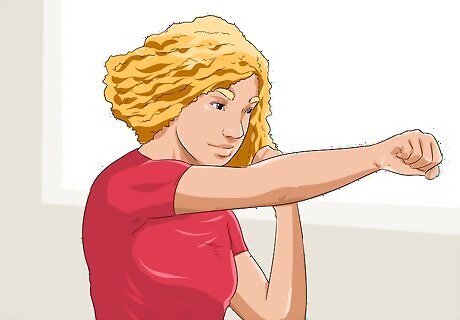
Practice each action individually before stringing it all together. For example, say your scene starts with traded punches, moves to a dodged kick, and ends with Kim throwing Ron to the ground. You should master the punches, the kick, and the throw individually, then slowly piece them together. When choreographing scenes, go slowly, taking it one piece at a time to ensure perfection and safety.
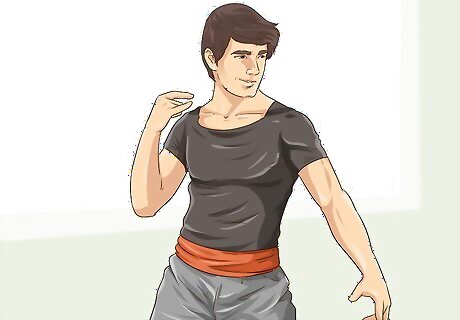
Add flourishes and details once the main actions are perfected. Think back to the tone of your fight, and the attitudes of your characters. For example, a noble and experienced warrior will be calm and confident. When not fighting they will be poised and still. A less experienced fighter, however, is generally jittery and nervous. They make big, energetic movements, bounce or shake when not in action, etc. Once your actual action is choreographed, spend some time making the fight look artistic. Make sure you rehearse in costume as well. Actors need to practice in the clothes they will actually have to fight in.
Filming The Scene
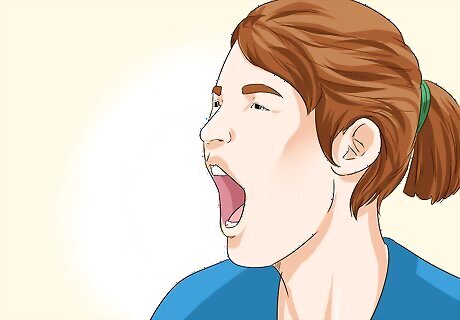
Share a safe word with every single person on set. If anyone is at all is uncomfortable with the fight, the choreography, or on-set safety, they need a way to instantly end it. Since "stop!" is something that people often shout during fights, you want a unique word that will cause everyone to immediately end the fight. Safety is paramount when staging fake fights-- while there should be no actual contact, there is a real chance of injury if someone misses a cue or maneuver.

Announce any time a scene is going to contain a fake weapon. This is incredibly important for everyone's safety. You may know that a knife is a prop, but that doesn't mean the rest of the cast, crew, or passerby will know that. Any scene with a fake weapon should be broadcast to everyone around. If in a public place, consider sticking someone on the street to intercept and warn passerby. If the police show up, do not try to convince them the weapon is fake immediately. Drop the weapon, put your hands up, and explain once you are asked.
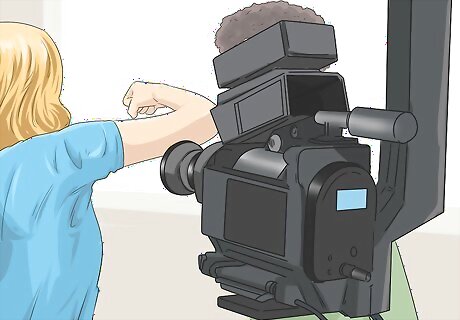
Place your camera so that it completely minimizes the air between the actors. For example, Kim is on the left of the screen and Ron is on the right, and Kim needs to punch Ron with her left hand. Kim could throw a hook around Ron's jaw, but to dodge him she'd have to pass by his nose, leaving a ton of empty air in front of him. To fix this, Kim could throw a straight punch, coming across his face and past Ron's ear, meaning the camera sees no empty space between the punch and Ron's face. Alternatively, put the camera behind Kim's shoulder. This way she can throw the hook in front of Ron's nose without anyone noticing she never actually hit him.
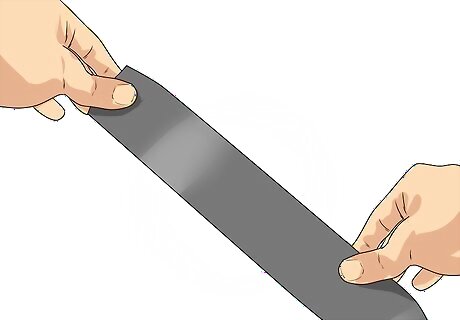
Give your actors "marks" on the actual set. Place tape on the ground that lets the actors know where they need to land each motion in order to be in the shot. This takes away the guesswork for each move and helps keep everyone safe -- you can be assured, for example, that the puncher stays six inches away from the one getting hit. Make sure these marks don't let the actors get blinded by lights or, even worse, put them in a place to slip on fake blood or something else on set. If you need to shoot down low and can see the floor, use the marks for rehearsal and only remove them once you're ready to shoot.
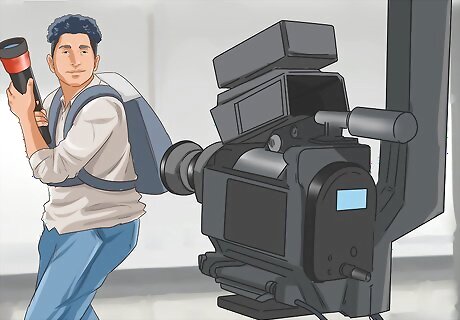
Shoot in pieces, focusing on one actor at a time. Don't try and capture everything at once -- it will be impossible. Instead, cover each fighter individually. If you have multiple cameras, you can often do this at once. However, one camera works too. Returning to Kim and Ron, get every one of Kim's punches 2-3 times, using slightly different angles. Then get Ron's reaction 2-3 times as well. This allows the editor to cut from Kim's punch to Ron's stumble backwards, helping hide the fact that Kim never actually hits Ron at all.

Hold the camera instead of using a tripod. A handheld camera will naturally shake, and you can quickly pivot it when needed. This allows you to "hide" the fake punches so that no one can tell that they didn't actually hit, and the shakiness lends the scene a frantic, high-energy feel. That said, do not intentionally shake the camera -- it will be far too wild to see anything. Just let your natural movement add a little bit of wobble to the shot.
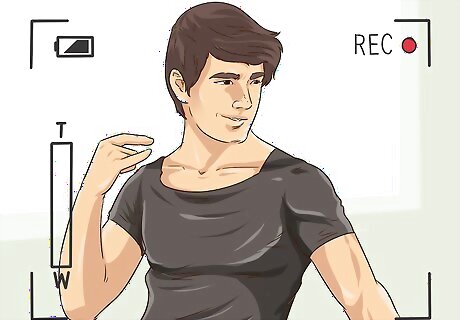
Keep the camera zoomed in. Great fight choreographers like Bruce Lee can get away with wide camera angles because they have the timing and athleticism to make every motion convincing. Most fight scenes, however, stay up close for any actual "contact" because it minimizes the distance you need to cheat with fake punches. Furthermore, tight angles make viewers feel like they are right in the middle of the action. Good chances to go wide are choreographed bits where no one actually gets hit -- such as sections where both fighters dodge several blows in a row.

Shoot away from safety equipment. If you're throwing a character, you'll want some pillows to land on. But you don't want these pillows in the shot. Once your fight is choreographed, come up with novel camera angles to hide the essential equipment. If a character slams into a wall, shoot from behind them so that the actor's body hides the safety pad. For the throw, a common choice is to shoot up at the person, so they fall towards the camera and land out of frame below it.
Piecing it Together

Use quick cuts to give the impression of action. The best way to hide the fact that fight is fake is to keep the cuts moving. This allows people to see the flying fists without needing to see the landing, as the audience's brain will fill in the part where the punch hit's the opponent's face, even though it didn't actually happen. The quicker the cuts the more frantic and chaotic a scene looks, which is perfect for fights. Don't be surprised, in a busy action scene, if many of your cuts are 2-3 second or shorter. You can go too fast, which makes a scene too confusing to follow. Find ways to slow the scene down occasionally, like using a long cut of a character catching their breath before jumping back into the fray.
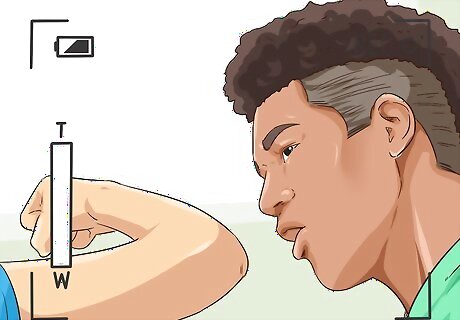
Hide each moment of contact in a cut. This is especially important if the shot of a fake punch seems fake. Start with a shot of Kim throwing her punch at Ron. Right as she would hit him in a real fight, cut to an angle of Ron starting his reaction away from her fist. The cut tells a viewer that contact was made without ever having to show it.
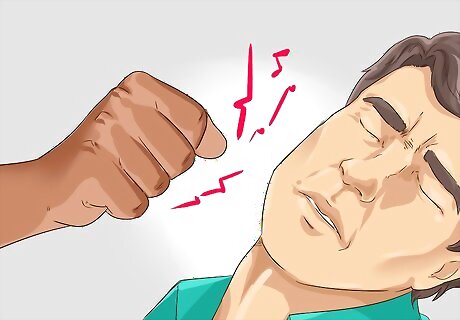
Focus on sound design to sell your fake fight scene. The visuals of a fight scene are hard to do, but it is the sound that truly distinguishes a good fight from a bad one. Timing up each punch with a bone-cracking sound effect, grunts from the actors, and whooshes of air as each kick flies takes hours of time, but will help your scene stand out. Go back and watch 2-3 of your favorite action scenes and pay attention to every single sound -- from footsteps to cries of pain. For really incredible scenes, you'll need to do "foley." This is when you record and create all the sound effects yourself, such as watching the scene and stomping in time with the action to create perfectly timed footsteps.

Have the actors add their personal sound effects to the final scene. Get the actors mic'd up and have them grunt, scream, and breath heavily in time with their actions on screen. Let them watch the scene 1-2 times to get ready for each moment, then simply turn the mic on and let them improvise the noises they might make in a real fight. You can make these noises yourself, but it is always better when the actual actors voice their own sound effects.
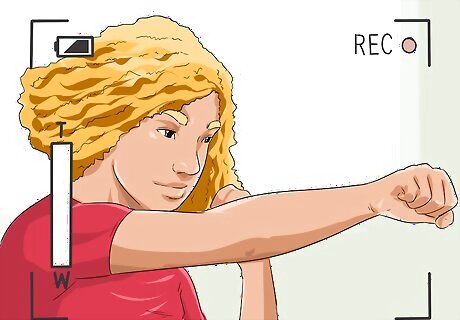
Aim for a scene with both clarity and chaos. Fight scenes are not easy to edit -- you want it to be clear what is happening, but also frantic and high-energy enough to mimic a real fight. Good ways to do this are to use lots of non-contact shots to show who is winning. For example, you might linger on a shot of the person getting hit to show they are losing, while showing lots of the winner throwing punches without getting hit back. Jackie Chan solved this problem by staging simple, clear fight scenes then speeding them up very slightly during editing. The result is a coherent fight with long cuts that is also high-energy.
















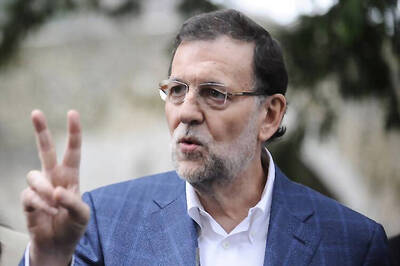



Comments
0 comment